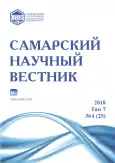Spatial organization of Cyclachaena xanthiifolia (Nutt.) Fresen. populations on the railway line
- Authors: Nikitin N.A.1
-
Affiliations:
- Samara State University of Social Sciences and Education
- Issue: Vol 7, No 4 (2018)
- Pages: 93-97
- Section: 03.02.00 – General Biology
- URL: https://journals.rcsi.science/2309-4370/article/view/21858
- DOI: https://doi.org/10.17816/snv201874116
- ID: 21858
Cite item
Full Text
Abstract
The spatial structure of populations under the conditions of anthropogenic impact is a very important indicator that reflects the behavioral patterns of the species, such as changes in the structure and aggregation of individuals. Quarantine weeds are the object of ecologists’ close attention, as these weeds carry the greatest danger to the population, since they most often cause pollinosis and a significant deterioration in the quality of life during seasonal outbreaks of the disease. That is why they should be investigated by methods of analyzing the spatial structure of their populations. Railways are considered to be corridors along which quarantine weeds and other alien and invasive species are able to spread to new territories. Spatial behavior of species, formation of aggregations and large clusters, or a uniform distribution of individuals can reveal a fundamental relationship between the conditions of anthropogenic impact along the right-of-way and the spatial structure of populations. Along the Kinel-Bezenchuk Kuybyshev railroad in the spatial structure of the population of Cyclachaena xanthiifolia (Nutt.) Fresen. there is a group and uniform distribution of individuals. Aggregation of individuals in clusters (group distribution) are found in the places with the highest anthropogenic load.
Keywords
Full Text
##article.viewOnOriginalSite##About the authors
Nikolay Alexandrovich Nikitin
Samara State University of Social Sciences and Education
Author for correspondence.
Email: nikitin_nikolai@inbox.ru
postgraduate student of Chair of Biology, Ecology and Methods of Teaching
Russian Federation, SamaraReferences
- Iwao S. A new regression method for analyzing the aggregation pattern of animal populations // Researches on Population Ecology. 1968. Vol. 10, № 1. P. 1-20.
- Taylor L.R. Aggregation, variance and the mean // Nature. 1961. Vol. 189. P. 732-735.
- Тейлор Д., Грин H., Стаут У. Биология: В 3-х т. Т. 2 / пер. с англ.; под ред. Р. Сопера 3-е изд. M.: Мир, 2004. 436 с.
- Olsvig L.S., Cryan J.F., Whittaker R.H. Vegetational gradients of the pine plains and barrens of Long Island // Pine Barrens: Ecosystem and Landscape / Ed. by R.T.T. Forman. New York: Academic Press, 1979. P. 265-282.
- Whittaker R.H. The ecology of serpentine soils. IV. The vegetational response to serpentine soils // Ecology. 1954. Vol. 35. P. 275-288.
- Whittaker R.H. A criticism of the plant association and climatic climax concepts // Northwest Science. 1951. Vol. 25. P. 17-31.
- Whittaker R.H. Gradient analysis of vegetation // Biological Reviews. 1967. Vol. 42. P. 207-264.
- Whittaker R.H. Communities and Ecosystems. New York: Macmillan, 1975. 385 p.
- Whittaker R.H. Evolution and measurement of species diversity // Taxon. 1972. Vol. 21. P. 213-251.
- Whittaker R.H., Likens G.E. The biosphere and man // Primary Productivity of the Biosphere / Ed. by H. Lieth, R.H. Whittaker. New York: Springer Verlag, 1975. P. 305-328.
- Whittaker R.H. Introduction // Handbook of Vegetation Science. Part V: Ordination and Classification of Vegetation / Ed. by R.H. Whittaker. The Hague: Junk B.V., 1973. P. 1-6.
- Shmida A., Whittaker R.H. Pattern and biological microsite effects in two shrub communities, southern California // Ecology. 1981. Vol. 62. P. 234-251.
- Gauch H.G. Jr., Whittaker R.H. Hierarchical classification of community data // Journal of Ecology. 1981. Vol. 69. P. 537-557.
- Tansley A.G. The use and abuse of vegetational concepts and terms // Ecology. 1935. Vol. 16, № 3. P. 284-307.
- Cliff A.D., Ord J.K. Spatial Processes. London: Pion, 1981. 266 p.
- Soutwood T.R.E. Ecological methods. London: Chapman & Hall, 1978. 524 p.
- Elliot J.M. Some methods for the statistical analysis of samples of benthic invertebrates. Freshwater Biological Association, 1977. 160 p.
- Одум Ю. Экология: В 2-х т. Т. 2 / пер. с англ. М.: Мир, 1986. 376 с.
- Morisita M. Measuring the dispersion of individuals and analysis of the distributional patterns // Memoirs of the Faculty of Science, Kyushu University. Series E: Biology. 1959. № 2. P. 215-235.
- Morisita M. Iσ-Index: a measure of dispersion of individuals // Researches on Population Ecology. 1962. Vol. 4, № 1. P. 1-7.
Supplementary files








